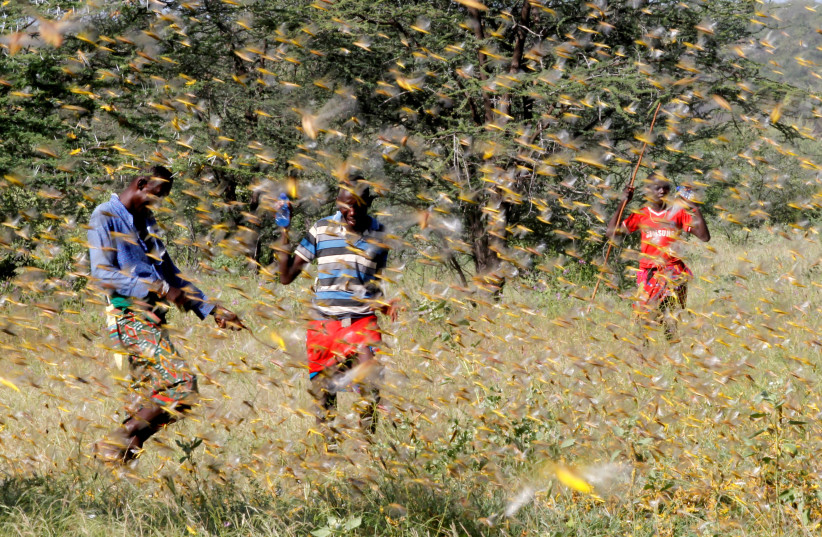Swarms of desert locusts are plaguing multiple countries throughout the world, including China, Jordan, Pakistan, Kenya and Sudan.
East Africa is being hit particularly hard by the swarms, with the United Nations warning of an unprecedented threat to food security in the region, according to Bloomberg. The outbreak is being caused by an increased number of cyclones and could become worse if weather trends continue.
The swarms have reached Ethiopia, Kenya, Somalia, Djibouti, Eritrea, Sudan, Uganda, South Sudan and Tanzania, among other countries.
In the biblical book of Exodus, locusts are one of 10 plagues delivered upon Egypt, also located in Africa, when Pharaoh refuses to let the Jewish people go.
“And the Lord said to Moses, ‘Stretch out your hand over Egypt so that locusts will swarm over the land and devour everything growing in the fields, everything left by the hail.’ So Moses stretched out his staff over Egypt, and the Lord made an east wind blow across the land all that day and all that night. By morning the wind had brought the locusts; they invaded all Egypt and settled down in every area of the country in great numbers. Never before had there been such a plague of locusts, nor will there ever be again” (Exodus 13-14).
UN Secretary General Antonio Guterres warned that “there is a link between climate change and the unprecedented locust crisis plaguing Ethiopia and East Africa. Warmer seas mean more cyclones generating the perfect breeding ground for locusts. Today the swarms are as big as major cities and it is getting worse by the day,” according to Bloomberg.
The infestation originated on the Arabian Peninsula in Yemen, with Saudi Arabia being impacted by the swarms as well. In June, Yemen saw an outbreak of desert locusts for the first time in three years. Yemenis took advantage of the infestation as an alternative food source.
“Its taste is delicious. If you eat one locust, you will end up wanting to eat five,” said Sanaa resident Wadai al-Nawdah to the Middle East Eye in June. “I walk every day after breakfast to find locusts for dinner. I have become addicted.”
In Jordan, the alert level related to locust control was raised to high as the Agriculture Ministry monitored the movement of locusts from Yemen to Saudi Arabia, according to the Jordan Times. Ministry staff are being trained to face the locusts with the support of the Royal Jordanian Air Force, the Royal Badia Forces and the Jordan Customs Department.
Syria, which also borders Israel, is reportedly preparing for an outbreak, as well.
Israel is preparing for the possibility of the first desert locust infestation in seven years, according to Channel 12 news. The infestation in 2013 caused hundreds of thousands of shekels in damages to the agricultural industry in Israel. In a recent situation evaluation, Agriculture Minister Tzachi Hanegbi said that there is currently only a low chance that the locusts will come to Israel, but stressed that the forecast could change and preparations should be made in advance.
Iran has also begun preparing for the swarms currently located south of the country. Mohammad Reza Mir, the agricultural expert in the Plant Protection Organization of Iran, told Xinhua that the locusts could invade as Iran’s central regions, as well.
In Asia, Pakistan has declared a national emergency to combat the locust infestation. The swarms there have reached northwest India as well. The locust swarms are approaching China as well.
A 1 sq. km. swarm of locusts can eat the same amount of food in one day as 35,000 people, according to the FAO. UN Food & Agriculture Organization locust forecasting expert Keith Cressman explained that one locust swarm that enters a field in the morning has eaten the entire field by midday.
Cressman warned “we have a very short window of time to act.” FAO Director-General QU Dongyu urged greater and faster action in order to prevent a humanitarian crisis in East Africa.
Swarms of desert locusts are devastating crops and pastures in East Africa.
This is the situation as of 10th February.
Experts fear it could grow 400 times by June if left untreated.
Learn more https://t.co/Hn9o1CjpW6 via @CNN #DesertLocust #Locusts pic.twitter.com/o4cqXsu9Dw
— FAO (@FAO) February 19, 2020
One swarm in Kenya was three times the size of New York City, according to CNN. The number of locusts could grow 400 times by June if not treated.
